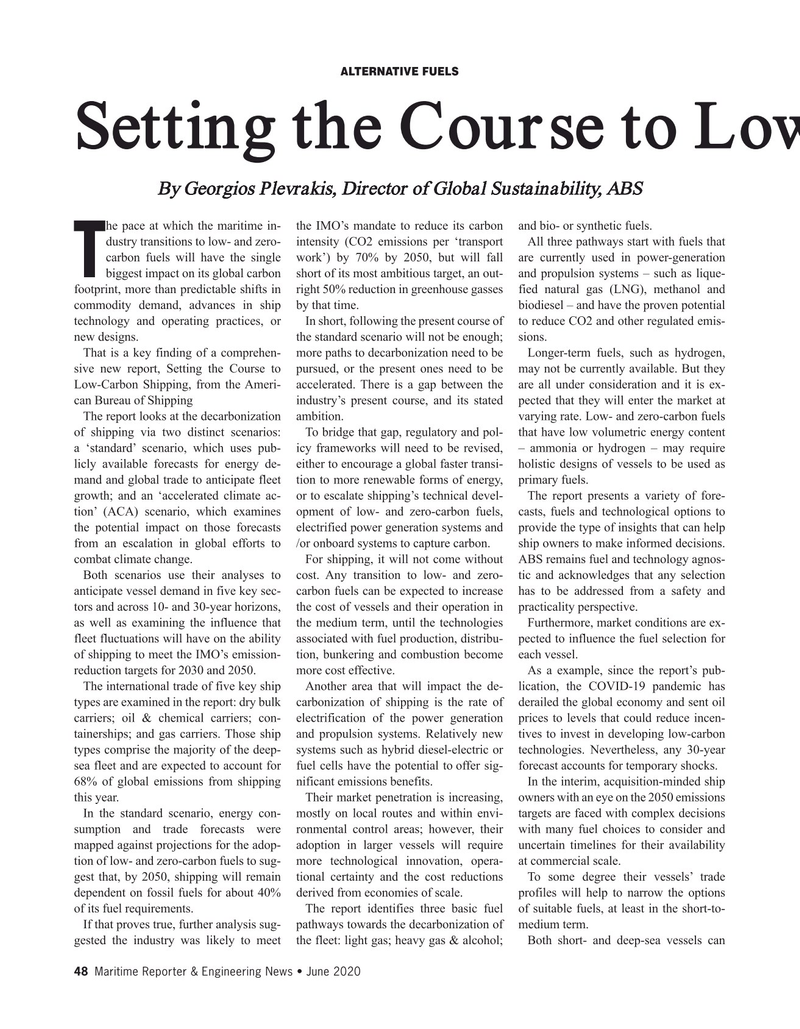
Page 48: of Maritime Reporter Magazine (June 2020)
2020 Yearbook
Read this page in Pdf, Flash or Html5 edition of June 2020 Maritime Reporter Magazine
ALTernATiVe fUeLs
Setting the Course to Low-Carbon Shipping
By Georgios Plevrakis, Director of Global Sustainability, ABS he pace at which the maritime in- the IMO’s mandate to reduce its carbon and bio- or synthetic fuels.
dustry transitions to low- and zero- intensity (CO2 emissions per ‘transport All three pathways start with fuels that carbon fuels will have the single work’) by 70% by 2050, but will fall are currently used in power-generation
Tbiggest impact on its global carbon short of its most ambitious target, an out- and propulsion systems – such as lique- footprint, more than predictable shifts in right 50% reduction in greenhouse gasses fied natural gas (LNG), methanol and commodity demand, advances in ship by that time. biodiesel – and have the proven potential technology and operating practices, or In short, following the present course of to reduce CO2 and other regulated emis- new designs. the standard scenario will not be enough; sions.
That is a key finding of a comprehen- more paths to decarbonization need to be Longer-term fuels, such as hydrogen, sive new report, Setting the Course to pursued, or the present ones need to be may not be currently available. But they
Low-Carbon Shipping, from the Ameri- accelerated. There is a gap between the are all under consideration and it is ex- can Bureau of Shipping industry’s present course, and its stated pected that they will enter the market at
The report looks at the decarbonization ambition. varying rate. Low- and zero-carbon fuels of shipping via two distinct scenarios: To bridge that gap, regulatory and pol- that have low volumetric energy content a ‘standard’ scenario, which uses pub- icy frameworks will need to be revised, – ammonia or hydrogen – may require licly available forecasts for energy de- either to encourage a global faster transi- holistic designs of vessels to be used as mand and global trade to anticipate fleet tion to more renewable forms of energy, primary fuels.
growth; and an ‘accelerated climate ac- or to escalate shipping’s technical devel- The report presents a variety of fore- tion’ (ACA) scenario, which examines opment of low- and zero-carbon fuels, casts, fuels and technological options to the potential impact on those forecasts electrified power generation systems and provide the type of insights that can help from an escalation in global efforts to /or onboard systems to capture carbon. ship owners to make informed decisions. combat climate change. For shipping, it will not come without ABS remains fuel and technology agnos-
Both scenarios use their analyses to cost. Any transition to low- and zero- tic and acknowledges that any selection anticipate vessel demand in five key sec- carbon fuels can be expected to increase has to be addressed from a safety and tors and across 10- and 30-year horizons, the cost of vessels and their operation in practicality perspective. as well as examining the influence that the medium term, until the technologies Furthermore, market conditions are ex- fleet fluctuations will have on the ability associated with fuel production, distribu- pected to influence the fuel selection for of shipping to meet the IMO’s emission- tion, bunkering and combustion become each vessel. reduction targets for 2030 and 2050. more cost effective. As a example, since the report’s pub-
The international trade of five key ship Another area that will impact the de- lication, the COVID-19 pandemic has types are examined in the report: dry bulk carbonization of shipping is the rate of derailed the global economy and sent oil carriers; oil & chemical carriers; con- electrification of the power generation prices to levels that could reduce incen- tainerships; and gas carriers. Those ship and propulsion systems. Relatively new tives to invest in developing low-carbon types comprise the majority of the deep- systems such as hybrid diesel-electric or technologies. Nevertheless, any 30-year sea fleet and are expected to account for fuel cells have the potential to offer sig- forecast accounts for temporary shocks. 68% of global emissions from shipping nificant emissions benefits. In the interim, acquisition-minded ship this year. Their market penetration is increasing, owners with an eye on the 2050 emissions
In the standard scenario, energy con- mostly on local routes and within envi- targets are faced with complex decisions sumption and trade forecasts were ronmental control areas; however, their with many fuel choices to consider and mapped against projections for the adop- adoption in larger vessels will require uncertain timelines for their availability tion of low- and zero-carbon fuels to sug- more technological innovation, opera- at commercial scale.
gest that, by 2050, shipping will remain tional certainty and the cost reductions To some degree their vessels’ trade dependent on fossil fuels for about 40% derived from economies of scale. profiles will help to narrow the options of its fuel requirements. The report identifies three basic fuel of suitable fuels, at least in the short-to-
If that proves true, further analysis sug- pathways towards the decarbonization of medium term.
gested the industry was likely to meet the fleet: light gas; heavy gas & alcohol; Both short- and deep-sea vessels can 48 Maritime Reporter & Engineering News • June 2020

 47
47

 49
49
